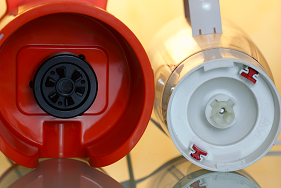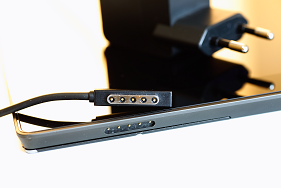The confidence in a brand is a delicate mechanism, which can be damaged by inadequate care of components and by an excessive “cost cutting”: a plastic gear that breaks is enough to lose a customer.
Vivien Reimbelli and Valentina Zambello
It seems that Alessandro the Great in the last instants of his glorious life pronounced the fateful phrase “I am dying thanks to the help of too many doctors”. It is what can happen to products that, even if conceptually excellent in terms of operation principle and manufacturing execution, undergo adjustment interventions (read “cost-cutting”) that provide for the replacement of components like gears, handles, guides and other mobile parts and that do not frustrate the initial enthusiasm of a happy user, baffling him to the extent of making him lose confidence in the brand. Let therefore a fundamental design phase of the appliance be followed by the stage of so called Gorilla Test, which puts to the test the mobile components of the equipment.
Perceived solidity
As well known, there are concrete satisfaction factors connected with tangible characteristics of the product but also factors more linked with an emotional component that sometimes can be the boosting element to the purchase of a determinate household appliance: brands are perfectly aware of that and in fact, even if they use plastic materials, they apply finishes recalling metal to convey an idea of solidity that satisfies the wish of “made to last”.
The automotive market perfectly represents this need and one of the assessment parameters of the solidity of a car when examined by users is the opening and closing of a door: the more this will be heavy and with precise closing the more the potential customer will perceive a sensation of overall solidity of the vehicle, in some case becoming a decisive element for the purchase. Concerning this, you can imagine how much care is put into the study of the door closing….
Also shapes can condition the solidity perception: thin and elongated shapes immediately transmit a sensation of fragility, as well as guides with difficult insertion or small-size complicated clutches with excessive backlashes convey a sensation of scarce durability. Also giving a “volume” to shapes helps in transmitting a perception of solidity and a hollow but voluminous body is certainly more appealing than a full one, if flat and without volume.
An interesting example is represented by a renowned producer of photographic objectives questioned by the market owing to its habit of equipping products of even thousand Euro value with plastic accessories of scarce reliability, with the result of igniting real flames on internet and of alienating numerous bloggers.
All the wheels in place
 While to be quirky and original may prove to be useful in the devising of a product, in the execution phase of the project it is advisable to maintain a more pragmatic approach because, if it is true that the current trend is to implement real design objects, it is worth reminding that the end user will finally use them. Without going into engineering details, we are reporting here some typical remarks of users’ world that can result in useful guidelines to which to refer in design phase.
While to be quirky and original may prove to be useful in the devising of a product, in the execution phase of the project it is advisable to maintain a more pragmatic approach because, if it is true that the current trend is to implement real design objects, it is worth reminding that the end user will finally use them. Without going into engineering details, we are reporting here some typical remarks of users’ world that can result in useful guidelines to which to refer in design phase.
Plugs: better if not too long, to avoid backlashes and bends that in the long term will cause a failure or a difficult operation. Let’s not forget that the user not always has the possibility of putting the right care in the machine use and resistance tests often do not take into account the reality of a mother with a baby in her arms who rapidly operates the starting control of a washing machine.
Wheels and gears: better if resistant and oversized. Obvious? Maybe, but in several appliances with moving gears that transmit force to an accessory, even if small, we can nothing but consider the possibility that the same undergoes an excessive stress and, without the right tolerance, a failure will be easily caused.
Guides and clutches: solid guides with inlets reducing the centring need, thus limiting the wear and the bends on guides themselves, low frictions and adequate tolerances to reduce backlashes. Clutches will always provide for a suitable stroke, aimed at reducing bends and, wherever there are power transmissions, appropriate materials and oversized pieces, to avoid that an incorrect positioning at the operation time turns into a disastrous “scratching” of pieces in contact. A standard example is represented by column blenders, where the power takeoff, if too small, in case of incorrect positioning of the cup, easily results in breakage.
Handles and controls: it is clear that we cannot imagine handles that break, but it often happens that fixing screws yield just enough to create a backlash that immediately generates discomfort in the user and gives a perception of appliance fragility. Without imagining the total detachment while we are grasping the appliance, it is indicator of imprecise design of shapes or of materials, in particular when a screw is housed in a much softer material than that composing it and easily generating wear.
Controls are the black ship of lots of appliances, even valid, which sooner or later simply stop …functioning! Pressure keys that get stuck, cursors that are blocked and pressure controls that do not operate anymore are extremely annoying because they not only create discomfort but they even completely prevent the appliance functioning. Also because Mr Murphy will make all that happen exactly when we needed that appliance and the need of asking for after sale service for a banal pushbutton makes all that even more frustrating.
Blogs, judgement without appeal
The importance of granting a correct and complete operation of appliances, besides being an ethical obligation, is particular important in an age in which social media amplify with immediate and viral effect any information, providing versions of events that do not permit denials. This is well known in Germany where the Sueddeutsche Zeitung has carried out a study on behalf of Greens in which was advanced the hypothesis that it was in course an action premeditated by manufacturers aimed at causing the household appliance failure once expired the guarantee, thus compelling to expensive repairs. The results of the study were diffused in the Internet cyberspace and bounced back by various bloggers, obtaining an impressive number of visits and people’s baffled comments, in particular by young blog visitors.
important in an age in which social media amplify with immediate and viral effect any information, providing versions of events that do not permit denials. This is well known in Germany where the Sueddeutsche Zeitung has carried out a study on behalf of Greens in which was advanced the hypothesis that it was in course an action premeditated by manufacturers aimed at causing the household appliance failure once expired the guarantee, thus compelling to expensive repairs. The results of the study were diffused in the Internet cyberspace and bounced back by various bloggers, obtaining an impressive number of visits and people’s baffled comments, in particular by young blog visitors.
Despite the information action brought forward by Zvei, the producer association, which explained how the average of household appliances in German houses is more than ten years old and then the mean is based on products far exceeding the warranty expiry terms, users preferred adopting the thesis of malice and fierce crusades were carried out on the web against producers.
Typical feature of the web is just diffusing first of all news meant for effect and obviously there is nothing better than to advance the conspiracy thesis. Unfortunately, the free and endless horizons of internet feed the Machiavellian rule of suspicion and, just quoting the statesman, “where the less you know the more you suspect”.
The success of “professionals”
 Begun more than ten years ago, the fashion of furnishing especially the kitchen with household appliances of clear professional inspiration is experiencing new splendour thanks to the media trend that sees squads of renowned and aspiring Chefs grapple with changing fortunes in dizzying culinary ventures. Common characteristic is the use of professional or semi-professional equipment.
Begun more than ten years ago, the fashion of furnishing especially the kitchen with household appliances of clear professional inspiration is experiencing new splendour thanks to the media trend that sees squads of renowned and aspiring Chefs grapple with changing fortunes in dizzying culinary ventures. Common characteristic is the use of professional or semi-professional equipment.
But what does confer a professional look to a household appliance? Certainly sizes, bigger on average (but not always) and certainly materials, essentially metal. And it is just metal that gives that perception of solidity that acts on the fetish side of fans, who gloat at the sight of food processors, ovens and hobs with performance worthy of a Chef and who, once overcome the fear of having to provide for a power plant at home to power all that, look forward to filling their house with new and shiny appliances.
Plastic v/s metal. What to do?
As we do not want to show detached snobbery towards the reality of an unfavourable general business trend, witnessing notable sufferance in the household appliance market, we indulge anyway in a serene reflection. If it is true that only high-end products can avail themselves of a completely metal structure, we can focus productive efforts on those previously listed details that can make the difference. The most accredited observers show that consumers are highly interested in innovation that, if well communicated, can bear a delta price, maybe not such as to be out of the market but sufficient to grant the “value for money” that, in times like current ones, is particularly felt and has positive effects on the brand. Certainly, we all would like highest quality products at favourable prices but it will be useful to consider sometimes some micro-choices that can really make the difference between having a satisfied user and living a brand abandoning.
sufferance in the household appliance market, we indulge anyway in a serene reflection. If it is true that only high-end products can avail themselves of a completely metal structure, we can focus productive efforts on those previously listed details that can make the difference. The most accredited observers show that consumers are highly interested in innovation that, if well communicated, can bear a delta price, maybe not such as to be out of the market but sufficient to grant the “value for money” that, in times like current ones, is particularly felt and has positive effects on the brand. Certainly, we all would like highest quality products at favourable prices but it will be useful to consider sometimes some micro-choices that can really make the difference between having a satisfied user and living a brand abandoning.
Innovation renovates and solves
As already said, innovation is the element that maintains the distinguishing features of products and increases their appealing but it can become also problem-solving of technical issues, with solutions that match originality and safe functionality. An example is the  solution of power supply of PC and tablets, which is based on a magnetic contact coupling and not on the classic plug. Because the experience of the producers of tablets and smarphones had highlighted a criticality, that’s to say that instruments daily connected with the net power supply for the recharge undergo a very high mechanical wear, up to failures in recharge procedures and the replacement of the parts involved. The innovation contained in the magnetic solution has shared in giving appeal to the product and at the same time in solving a criticality.
solution of power supply of PC and tablets, which is based on a magnetic contact coupling and not on the classic plug. Because the experience of the producers of tablets and smarphones had highlighted a criticality, that’s to say that instruments daily connected with the net power supply for the recharge undergo a very high mechanical wear, up to failures in recharge procedures and the replacement of the parts involved. The innovation contained in the magnetic solution has shared in giving appeal to the product and at the same time in solving a criticality.
It is possible that the simple replacement of the materials that compose a part of the appliance is not the solution or, due to cost-weight-overall dimensions reasons, does not represent the best. The innovation also in the small details of a household appliance can become the real egg of Columbus, proposing ameliorative solutions for the use comfort and, why not, making the aesthetics of the appliance really sexy!




